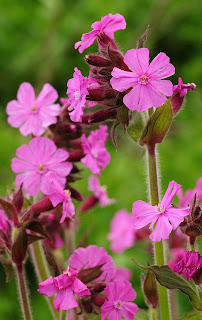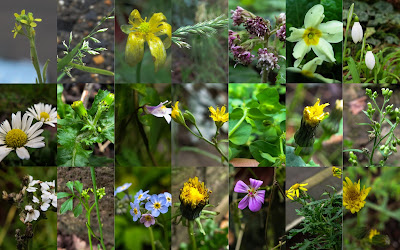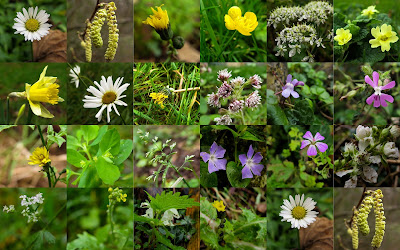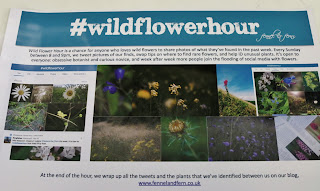 |
Yarrow Achillea millefolium
Image: Gus Routledge |
Last year we started the tradition of New Year Plant Hunt prizes: awarded by me, intended as a bit of fun and of no financial value whatsoever! Last year, prizes went to Tim, to Phoebe, to Lin, to Oisin and to Dawn.
This year, I noticed two recorders who had obviously 'got the bug' and were heading out for multiple New Year Plant Hunts. Gus and James notched up five Hunts each over the four-day period so they both win the newly-inaugurated Most Hunts prize! Each of them is invited to tell us about their Hunts and then share their three botanical wishes for 2016 on these pages. First up is Gus:
"My plan to do the New Year Plant Hunt first started when I
saw BSBI tweeting about it, and Christmas certainly helped as I got the Collins
Flower Guide, along with a few others.
 |
Ivy-leaved Toadflax Cymbalaria muralis
Image: Gus Routledge |
A few days before Christmas, however, I was invited to join
Wild Reekie (a group based focused on enjoying and restoring the beauty and
variety of nature right in Edinburgh) for a New Year Plant Hunt which happened
to be on my local patch of the Hermitage of Braid and Blackford Hill. It was
great being around people with similar interests, talking about wildflowers,
ferns, bees, and such. It also meant more eyes to look for flowers! In the end
we managed 16 species, which I added to on my walk home with a further 8
species in the last half hour; 24 species in total.
Once home I still had a craving to see more flowers, so I
headed into the Braid Hills in near darkness to find 7 species. Perhaps I would
have managed more if it hadn’t been so dark!
 |
Hairy Bitter-cress Cardamine hirsuta
Image: Gus Routledge |
On the 2nd January I decided to try a habitat not many people would
bother checking, and went into the Moorfoot Hills, around 500m altitude, where
I discovered, to my surprise, 4 species in flower, including a single Bell
Heather Erica cinerea. It was “dreich” as we Scots call it, i.e. very grim
weather-wise! But it did mean I could try something I’d always wanted to do:
drink water from Sphagnum moss. It tasted… earthy, but wasn’t half bad! The
following day I went to Arniston Estate where I figured the valley would
perhaps shelter flowers and encourage more to be on show. 14 species there, and
it included some lovely Ivy-leaved Toadflax Cymbalaria muralis which I’d never
noticed before becoming completely addicted to plant hunting!
The last day of the New Year Plant Hunt took me to Holyrood Park where I had seen a few flowers before Christmas and hoped some would still
be around. Thankfully, a lot of them were, and somehow I spotted this little
flower growing at the side: Hairy Bitter-cress Cardamine hirsuta, my favourite find
over the 4 days of the New Year Plant Hunt.
 |
Gorse Ulex europaeus
Image: Gus Routledge |
I thoroughly enjoyed my introduction into the world of
botany, and it’s been so easy to get into! Taking into consideration I got my
field guide 6 days before starting the New Year Plant Hunt, I managed to
identify 33 species in total. And of course, all the help I’ve received on
social networks and from people I’ve met has helped a lot as well.
Now I’m just eager for the year to progress and for more
flowers to be out in bloom! I suspect I’ll be making more trips specifically to
see flowers and I’m also going to try to get into recording so that my
sightings count towards something!
My first wish, is for more people to become aware of
Plantlife’s Road Verge Campaign. It really frustrates me that almost every road
verge I see is so bland and boring. Let there be colour! Everybody loves to see
flowers, so why not allow them to flourish in one of the few places that we can
definitely do so?
 |
Giant Butterbur Petasites japonicus
Image: Gus Routledge |
Wish number 2, something that I’ve always hoped would happen
at some point, is for more access to learning about the outdoors for young
people. They don’t have to become as enthralled in it all as I am, just a
better understanding of the natural world. This would help young people to
understand the need for threats to biodiversity, individual species, and
habitats to be dealt with and gotten rid of. If more people understood the
natural world, it would be far easier to encourage them to protect it.
Thirdly, I wish that there was a resource that allowed you
to easily find sites in your area that are of particular botanical interest.
Being a beginner, I don’t know where to go for areas that will hold interesting
plants, or many plants. At the moment I tend to walk around places I know well
in order to find flower and other plants, but I suspect there are plenty areas
in which I will find more that I don’t know of."
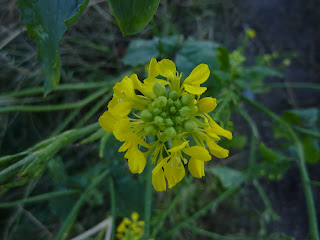 |
Rape Brassica napus
Image: Gus Routledge |
Many thanks to Gus for telling us about his New Year Plant Hunts and sharing his three botanical wishes for 2016. Plantlife, our partners in the National Plant Monitoring Scheme, are doing a great job raising awareness of wildflowers 'On the Verge' and are working with local authorities to optimise cutting times so that species are able to set seed. BSBI also applauds all attempts to engage younger members with the natural world and especially our wild flowers.
Wish number three is a really good one - Gus isn't the first person to wonder where all the most interesting wild flowers are in his local area. If there's one plant in particular you want to see, you can check the BSBI Distribution Database and get a rough idea where it has been recorded (BSBI members and active recorders can also request access at a finer scale) but what if you want to know all the plants in a given grid square? Or at a certain postcode?
If you can help grant any of Gus's three wishes, please get in touch!


